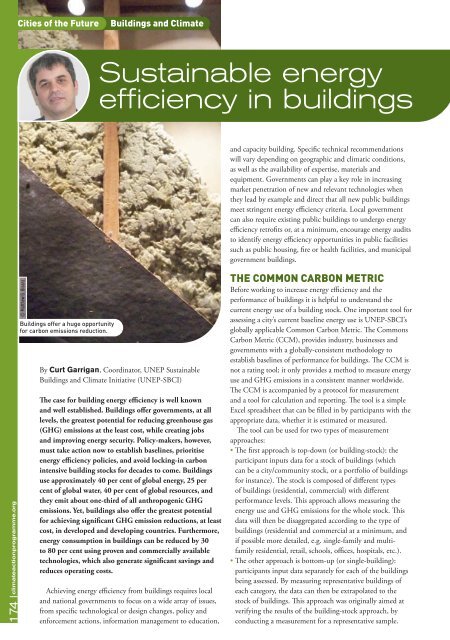Climate Action 2011-2012
You also want an ePaper? Increase the reach of your titles
YUMPU automatically turns print PDFs into web optimized ePapers that Google loves.
Cities of the Future<br />
buildings and <strong>Climate</strong><br />
Sustainable energy<br />
efficiency in buildings<br />
and capacity building. Specific technical recommendations<br />
will vary depending on geographic and climatic conditions,<br />
as well as the availability of expertise, materials and<br />
equipment. Governments can play a key role in increasing<br />
market penetration of new and relevant technologies when<br />
they lead by example and direct that all new public buildings<br />
meet stringent energy efficiency criteria. Local government<br />
can also require existing public buildings to undergo energy<br />
efficiency retrofits or, at a minimum, encourage energy audits<br />
to identify energy efficiency opportunities in public facilities<br />
such as public housing, fire or health facilities, and municipal<br />
government buildings.<br />
174 climateactionprogramme.org<br />
© Matthew G. Bisanz<br />
Buildings offer a huge opportunity<br />
for carbon emissions reduction.<br />
By Curt Garrigan, Coordinator, UNEP Sustainable<br />
Buildings and <strong>Climate</strong> Initiative (UNEP-SBCI)<br />
The case for building energy efficiency is well known<br />
and well established. Buildings offer governments, at all<br />
levels, the greatest potential for reducing greenhouse gas<br />
(GHG) emissions at the least cost, while creating jobs<br />
and improving energy security. Policy-makers, however,<br />
must take action now to establish baselines, prioritise<br />
energy efficiency policies, and avoid locking-in carbon<br />
intensive building stocks for decades to come. Buildings<br />
use approximately 40 per cent of global energy, 25 per<br />
cent of global water, 40 per cent of global resources, and<br />
they emit about one-third of all anthropogenic GHG<br />
emissions. Yet, buildings also offer the greatest potential<br />
for achieving significant GHG emission reductions, at least<br />
cost, in developed and developing countries. Furthermore,<br />
energy consumption in buildings can be reduced by 30<br />
to 80 per cent using proven and commercially available<br />
technologies, which also generate significant savings and<br />
reduces operating costs.<br />
Achieving energy efficiency from buildings requires local<br />
and national governments to focus on a wide array of issues,<br />
from specific technological or design changes, policy and<br />
enforcement actions, information management to education,<br />
The Common Carbon meTriC<br />
Before working to increase energy efficiency and the<br />
performance of buildings it is helpful to understand the<br />
current energy use of a building stock. One important tool for<br />
assessing a city’s current baseline energy use is UNEP-SBCI’s<br />
globally applicable Common Carbon Metric. The Commons<br />
Carbon Metric (CCM), provides industry, businesses and<br />
governments with a globally-consistent methodology to<br />
establish baselines of performance for buildings. The CCM is<br />
not a rating tool; it only provides a method to measure energy<br />
use and GHG emissions in a consistent manner worldwide.<br />
The CCM is accompanied by a protocol for measurement<br />
and a tool for calculation and reporting. The tool is a simple<br />
Excel spreadsheet that can be filled in by participants with the<br />
appropriate data, whether it is estimated or measured.<br />
The tool can be used for two types of measurement<br />
approaches:<br />
• The first approach is top-down (or building-stock): the<br />
participant inputs data for a stock of buildings (which<br />
can be a city/community stock, or a portfolio of buildings<br />
for instance). The stock is composed of different types<br />
of buildings (residential, commercial) with different<br />
performance levels. This approach allows measuring the<br />
energy use and GHG emissions for the whole stock. This<br />
data will then be disaggregated according to the type of<br />
buildings (residential and commercial at a minimum, and<br />
if possible more detailed, e.g. single-family and multifamily<br />
residential, retail, schools, offices, hospitals, etc.).<br />
• The other approach is bottom-up (or single-building):<br />
participants input data separately for each of the buildings<br />
being assessed. By measuring representative buildings of<br />
each category, the data can then be extrapolated to the<br />
stock of buildings. This approach was originally aimed at<br />
verifying the results of the building-stock approach, by<br />
conducting a measurement for a representative sample.












